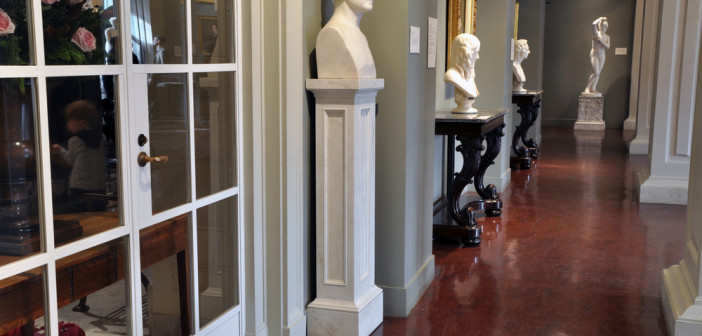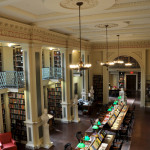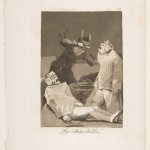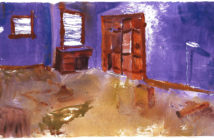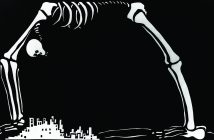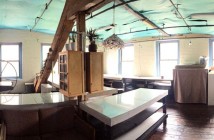Last week, in a locked room on the upper level of the Boston Athenaeum, I spent an afternoon leafing through the pages of a first edition copy of Francisco de Goya y Lucientes’s Los Caprichos. Bound in 1799 in crimson Moroccan leather at the private bindery of King Charles IV of Spain, this set of 80 prints serves as the artist’s indictment of his country for its myriad social ills in the death rattle of the Inquisition.
 She Fleeces Him (Le descañona), from The Caprices (Los Caprichos), plate 35
She Fleeces Him (Le descañona), from The Caprices (Los Caprichos), plate 35Francisco de Goya y Lucientes
Gift of M. Knoedler & Co., 1918
I had gone to the Athenaeum with the intention of writing about the fiftieth print in the set (Los Chinchillas), because the square heads and gaping maws of the figures depicted purportedly inspired Boris Karloff’s iconic costume for the 1931 film adaptation of "Frankenstein." But as I flipped through the volume (that is to say, as I painstakingly transitioned from gilt page to gilt page under the supervision of a research librarian), I found myself returning again and again to a plate marked "35" in careful script: Le descañona.
"Le descañona" can be translated succinctly as, "She fleeces him," though various manuscripts attributed to Goya provide two lines of additional commentary on the piece: "They shave him close and fleece him. It is his own fault for putting himself in the hands of such a barber." But such explanations should not be accepted at face value, given the impossibility of verifying that these manuscripts were penned, or even dictated, by the artist himself. In addition, evidence suggests that Goya, as a precautionary measure, selected intentionally misleading titles for his prints in order veil the criticism he leveled at the government, the Catholic Church, and the royal family. I was fortunate, therefore, to arrive at the Athenaeum with fresh eyes and ignorance afforded to me by a lack of working knowledge of the Spanish language (outside of a selection of rude words the names of cardinal numbers up to ten). I figured that "Le descañona" must be the name of some obscure, erotic dance native to the Iberian Peninsula.
The composition of this print is governed by a backdrop of stacked aquatinted wedges of varying tones, which serve to construct the architecture of the setting: an attic room with a sloped ceiling. Goya lights the rooms from a window to the left, and in select areas he has employed a courser grain of resin, dappling the continuous tone in such a way as to suggest the slanted sunlight of the late afternoon -- a time of day made dreamy and romantic by the languidness it inspires in us.
But this tranquility is slashed to ribbons by a solid bolt of aquatint striating the scene. This wedge calls to mind the cocked trigger of a gun -- or, if we look to the dead center of this print, the crook of the hairdresser’s arm as she brandishes her shears. The jingling of her bracelets is almost audible as she brushes back her seated client’s hair with a flick of her wrist, laying her second hand possessively atop her client’s yielding head. These figures echo the biblical story of Samson and Delilah, which is perhaps the best example in all of history of the intersection of love, betrayal, and cosmetology. Just as Delilah renders Samson impotent by robbing him of his precious locks (and thus the seat of his power), the hairdresser in Goya's print compels her client to bind his heart to her, while she in turn binds his body up in swaths of white cloth.
The artist reserves the use of aquatint in this print for building the novel and inviting architecture of the setting, which draws viewers into the scene before they have had a chance to notice that these same grey blocks also constitute a kind of warning flare. The central aquatinted bolt hangs emblematically over print, like a banner at a Soviet rally. But instead of a hammer and sickle, the print is emblazoned with the shape of the formidable crook of the hairdresser's arm, ready to strike.
The client is willingly drawn into the dream of a dalliance with the hairdresser. And perhaps the client will reside in this dream forever. Or perhaps, like the viewer, the client will by degrees come to see this cozy pied-à-terre in the sparkling light of the late afternoon for what it really is: a drab attic room, choked with dust.
- The Long Room, Megan Manton/Boston Athenæum.
- Francisco José de Goya y Lucientes, “The Sleep of Reason Produces Monsters,” from Los Caprichos, 1799. Boston Athenæum, Athenæum purchase, John Bromfield Fund, 1830.
- Second Floor Reading Room, Megan Manton/Boston Athenæum.
- She Fleeces Him (Le descañona), from The Caprices (Los Caprichos), plate 35 Francisco de Goya y Lucientes Gift of M. Knoedler & Co., 1918
- The Chinchillas (Los Chinchillas), from The Caprices (Los Caprichos), plate 50 Francisco de Goya y Lucientes Gift of M. Knoedler & Co., 1918

